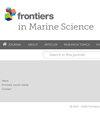Increased miRNA-375 causes oxidative damage but promotes apoptosis resistance and cell migration in the clam Ruditapes philippinarum
IF 3
2区 生物学
Q1 MARINE & FRESHWATER BIOLOGY
引用次数: 0
Abstract
MicroRNA is an important regulatory factor at the post-transcriptional level. Previous miRNAomics analysis found that miRNA-375 was steadily upregulated in the clammiRNA-375的增加引起菲律宾蛤的氧化损伤,但促进细胞凋亡抵抗和细胞迁移
微RNA是转录后水平的重要调控因子。先前的 miRNA 组学分析发现,在氨氮暴露下,miRNA-375 在蚬 Ruditapes philippinarum 中持续上调。然而,我们对其调控机制尚不了解。在本研究中,我们在蛤蜊体内注射了 miRNA-375 模拟物/抑制剂。然后,采用 qRT-PCR、酶测定和超微结构观察相结合的方法,分别研究其对相关基因、细胞参数和组织学结构的调控作用。结果表明,miRNA-375的表达增加会干扰其靶基因和氨毒性相关基因的表达水平,从而可能导致氧化应激、受损细胞迁移、细胞凋亡抵抗和肿瘤形成的可能性增加。此外,miRNA-375 会增加 MDA 含量,但会降低谷氨酸含量,并对蛤鳃造成严重的结构损伤。因此,miRNA-375 的增加可能会诱导氧化损伤,但促进细胞抗凋亡和细胞迁移,从而给菲利宾纳氏蛤带来灾难性的命运。总之,本研究首次揭示了 miRNA-375 在文蛤体内的调控作用,为了解氨氮对海洋双壳类动物的毒理机制提供了宝贵的线索。
本文章由计算机程序翻译,如有差异,请以英文原文为准。
求助全文
约1分钟内获得全文
求助全文
来源期刊

Frontiers in Marine Science
Agricultural and Biological Sciences-Aquatic Science
CiteScore
5.10
自引率
16.20%
发文量
2443
审稿时长
14 weeks
期刊介绍:
Frontiers in Marine Science publishes rigorously peer-reviewed research that advances our understanding of all aspects of the environment, biology, ecosystem functioning and human interactions with the oceans. Field Chief Editor Carlos M. Duarte at King Abdullah University of Science and Technology Thuwal is supported by an outstanding Editorial Board of international researchers. This multidisciplinary open-access journal is at the forefront of disseminating and communicating scientific knowledge and impactful discoveries to researchers, academics, policy makers and the public worldwide.
With the human population predicted to reach 9 billion people by 2050, it is clear that traditional land resources will not suffice to meet the demand for food or energy, required to support high-quality livelihoods. As a result, the oceans are emerging as a source of untapped assets, with new innovative industries, such as aquaculture, marine biotechnology, marine energy and deep-sea mining growing rapidly under a new era characterized by rapid growth of a blue, ocean-based economy. The sustainability of the blue economy is closely dependent on our knowledge about how to mitigate the impacts of the multiple pressures on the ocean ecosystem associated with the increased scale and diversification of industry operations in the ocean and global human pressures on the environment. Therefore, Frontiers in Marine Science particularly welcomes the communication of research outcomes addressing ocean-based solutions for the emerging challenges, including improved forecasting and observational capacities, understanding biodiversity and ecosystem problems, locally and globally, effective management strategies to maintain ocean health, and an improved capacity to sustainably derive resources from the oceans.
 求助内容:
求助内容: 应助结果提醒方式:
应助结果提醒方式:


